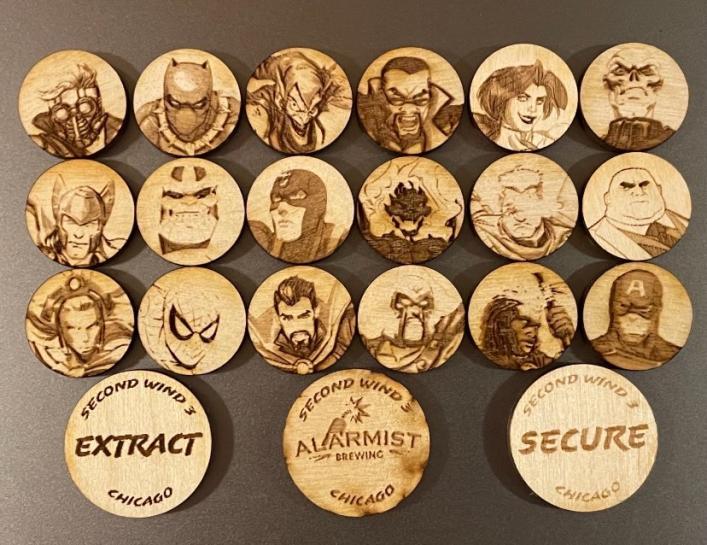Player Rules
FORMAT
Second Wind will be a Challenger event, using the Standard timeline as outlined in the AMG Challenger rules document https://www.atomicmassgames.com/marvel/op. In a few cases, we diverge from the rules template provided there, which are detailed below.
Miniatures
Each player must have the miniature for each character on their roster. Players are allowed to customize their miniatures as they like but must follow these guidelines:
- The miniature must be made from a majority of Atomic Mass Games miniature parts from the Marvel: Crisis Protocol miniatures line.
- The miniature must be easily identifiable as the character it represents.
- The size or pose of a customized miniature cannot interfere with game play.
- Miniatures must always be attached to an Atomic Mass Games base or a modeled base that is the appropriate size and shape of the original miniature.
Cards
A player must have all Character cards, Team Tactic cards, and Crisis cards included in their roster. Proxies of cards are allowed if approved by the EO and must have the full rules text included.
Dice
Players should use official Marvel: Crisis Protocol dice, which includes the dice found in the Core Box, Dice Expansions, and/or promotional material distributed by Atomic Mass Games. Players may use replacement dice if approved by the EO.
Measurement Tools
- Choose one set of widgets and use those for the entire game.
- When a model is pushed or thrown a declared distance, it is assumed that the model can be pushed or thrown back the same distance and return to the same point. (This is commonly a result of someone with new widgets throwing a model off an objective and then the model being pushed back onto the point with the old widgets)
Deployment (The Pastrami Rule)
As the mats are only pre-marked in one orientation, players are not allowed to rotate the mat and can only choose to deploy from one of the two edges facing the chairs.
USE OF TIMING DEVICES
Swiss Round Times
Each event round of Marvel: Crisis Protocol is a predetermined length, giving players a certain amount of time to complete their games. The EO should start the timer for an event round after most players have found their seats and begun to set up. If a game has not concluded when the time for an event round runs out, the player with the most victory points (VPs) is the winner. In the case of a tie, players will immediately score the table as if the round had ended. If it is still a tie at this point, it will be recorded as a draw.
This event will use a 100 minute round timer.
Chess Clocks
Chess clocks will be used for Second Wind. Chess clocks should be set to 45 minutes per player. When a player’s clock runs out, they immediately lose the game regardless of current VPs.
At the start of the game, the clocks will remain paused until deployment and the first power phase is complete, at which point the priority player will start their clock and take their first turn.
Each player is responsible for their own time. A player has the right to pass the time to their opponent whenever the opponent is making an action or spending time thinking about a decision. For example, an opponent deciding on using or resolving a reactive superpower such as Tricks And Traps or Lifesaver would be an instance to flip the clock onto the opponents time. While an opponent simply rolling defence dice would be an instance where you would keep the time running on your own clock.
The clock may be paused at the players’ discretion to resolve rules queries or judge calls. Excessive pausing of the clock will be considered time wasting by the judges and may be penalised.
In order to ensure timing in tournament games is fair and reasonable, at the end of the round the clock is immediately paused for the entirety of the Cleanup Phase and the following Power Phase. If either player is taking an excessive amount of time to resolve any decisions or player effects, a judge should be called to help resolve the issue.
PAINTING COMPETITION
Second Wind’s painting competition will have three categories, judged by a panel of painting experts:
- Best Roster
- Best Hero
- Best Villain
Each player may submit one entry each to all three categories. No player can win more than a single category.
The “Roster” category concerns the set of 10 models the player is using in the tournament. The “Hero” and “Villain” individual model categories concern a single model each, chosen by the player, that is among the models the player is using in the tournament.
When submitting models for the painting competition, players will be required to indicate which models they are submitting to the individual model categories. Slips of paper will be provided to label painting submissions and indicate models. If a player fails to indicate a model for one of the two individual model categories, they will not be considered in contention for that category. One model cannot be submitted for both “Hero” and “Villain” categories even if that character has canonically been considered both a hero and a villain.
The painting competition will take place during lunch on Saturday Oct. 21st, and the winners will be announced in the closing ceremony on Sunday Oct. 22nd.
BEST IN AFFILIATION PRIZES
At the end of the event, Second Wind will be giving out a custom token to the best player in each affilation. Winners will be determined by the final standings and awarded to the highest placing player for each affiliation. In the case where a player brought a multi affilation roster they will be able to pick the token for any affiliation that they played at least one game with during the event.
Example tokens from previous years:
